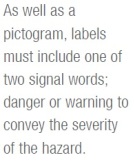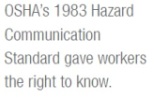by Paul Sambrook — U.S. facility professionals working with hazardous materials will be affected by global changes to hazard labels on chemical products, part of a United Nations effort for worldwide standardization. Tasked with implementing the changes and ensuring a positive impact, the U.S. Department of Labor’s Occupational Safety & Health Administration (OSHA) is revisiting its existing hazard communication standard.
“Exposure to hazardous chemicals is one of the most serious threats facing American workers today,” said U.S. Secretary of Labor Hilda Solis in March 2012. “Revising OSHA’s Hazard Communication standard will improve the quality and consistency of hazard information, making it safer for workers to do their jobs and easier for employers to stay competitive.”
The changes are due to the U.S. adopting the United Nations’ Globally Harmonized System of Classification and Labelling of Chemicals, known as the GHS. This is a global best practice approach to hazard communication, providing criteria for classification of hazards and a specific approach to labelling and safety data sheets. It was negotiated over several years by hazard communication experts from governments in the United States, Australia, Canada, China, Japan and the United Kingdom, as well as international organizations and other stakeholders.
Adoption of GHS
Countries adopting the GHS implement the suggestions through their own regulatory processes and procedures. In the European Union (E.U.), GHS is being adopted by all E.U. members via the European Regulation (EC) No 1272/2008 on Classification, Labelling and Packaging of Substances and Mixtures, known as the CLP Regulation. Japan was one of the first countries to implement the changes, amending its Industrial Safety and Health Law to reflect the GHS back in 2006. Australia is also well advanced in its preparations with its Work Health and Safety (WHS) Regulations, based on the GHS, coming into effect this year.
OSHA believes the revised standard will benefit workers by providing easy-to-understand information on the appropriate handling and safe use of hazardous chemicals. “[This] will result in increased safety and health for the affected employees and reduce the numbers of accidents, fatalities, injuries, and illnesses associated with exposures to hazardous chemicals.” OSHA estimates the revised standard will result in the prevention of 43 deaths and 585 injuries and illnesses annually. This reduction in occupational risks has an estimated value of US$250 million a year.
There are other benefits. U.S. businesses that regularly handle, store and use hazardous chemicals are predicted to see reduced trade barriers and improved productivity while businesses that have to periodically update safety datasheets and labels will see cost savings. OSHA estimates savings of US$475.2 million from productivity improvements for health and safety managers and logistics personnel, US$32.2 million during periodic updating of SDSs and labels, and US$285.3 million from simplified hazard communication training.
New hazard symbols

The most eye-catching change is to the hazard symbols on product labelling. Now just nine pictograms, colored black on a white background with a red diamond shaped border, are being used throughout the world to represent chemical health, physical and environmental hazards: a person represents chronic health hazards such as cancer and respiratory sensitisation; a flame represents flammables; an exclamation mark represents irritant substances and acute toxicity; a skull and crossbones represents acute toxicity; a test tube and hand represents corrosion; a flame over a circle represents oxidizers; an exploding bomb represents explosives; a gas cylinder represents gases under pressure; and a fallen tree represents aquatic toxicity. In the U.S., the new Hazard Communication Standard (HCS) does not require the fallen tree pictogram to be used since environmental hazards are not within OSHA’s jurisdiction.
As well as a pictogram, labels must include one of two signal words—danger or warning—to convey the severity of the hazard. Danger refers to more severe hazards. There also must be a hazard statement, a standardized phrase about the hazards of chemical substances and mixtures—”flammable gas,” “combustible liquid” or “toxic if swallowed” are just a few examples. Also required is a precautionary statement, a standardized phrase describing the steps that should be taken should someone be exposed to a hazardous chemical—examples are: “IF SWALLOWED: Immediately call a POISON CENTER or doctor/physician,” “IF ON SKIN: Gently wash with soap and water” and “IF ON CLOTHING: Rinse immediately contaminated clothing and skin with plenty of water before removing clothes.”
The Chemical Hazards Communication Society (CHCS) in the U.K., which provides information and training about chemical hazards regulations and international codes, thinks that having a standardized approach to labelling will be better for both businesses and consumers. Referring to the CLP Regulation being adopted in E.U. counties, Stuart Longworth, chairman of the CHCS, said, “The regulations governing the new labels are an essential part of the Globally Harmonized System of Classification and Labeling of Chemicals (GHS). They will make life easier for consumers when they travel and businesses when they import and export products because there will eventually only be one set of symbols to deal with throughout most of the world.”
Hazard classification also is changing with specific criteria now being used to classify health and physical hazards. This will help to ensure manufacturer consistency as to the impact of chemical hazards. Labels and safety datasheets will be more accurate. The final change is to safety datasheets, which now have a specified 16-section format.
Adapting to the revised standard

So how are U.S. organizations that use, manufacture or import hazardous chemicals affected by the changes? OSHA estimates that more than 5 million U.S. workplaces, with approximately 43 million employees that deal with hazardous chemicals in their job, will be affected by the revised standard. Within this total, an estimated 90,000 workplaces with almost 3 million workers actually create hazardous chemicals. Fortunately, implementation is to be phased in over the next few years, giving everyone time to comply with and get used to the changes. By Dec. 1, 2013, employers should have trained employees on the new labelling and safety datasheet format. By June 1, 2015, chemical manufacturers, importers, distributors and employers should be in compliance with the standard, with the exception of the provision not to ship containers labelled by the chemical manufacturer or importer unless it is a GHS label. Compliance with this is by Dec. 1, 2015. By June 1, 2016, employers should have updated the workplace labelling and hazard communication program as necessary, and provided extra training for newly identified physical or health hazards.

So, given the cost of the revised standard—an estimated US$201 million a year—is the update welcome? Undoubtedly, said Assistant Secretary of Labor for Occupational Safety and Health David Michaels, Ph.D., MPH, given the benefits to workers: “OSHA’s 1983 Hazard Communication Standard gave workers the right to know. As one participant expressed during our rulemaking process, this update will give them the right to understand, as well.” FMJ

Paul Sambrook is group commercial director at U.K.-based facilities services provider Servest Multi Service Group. Servest has embarked on a review of its labeling standards.